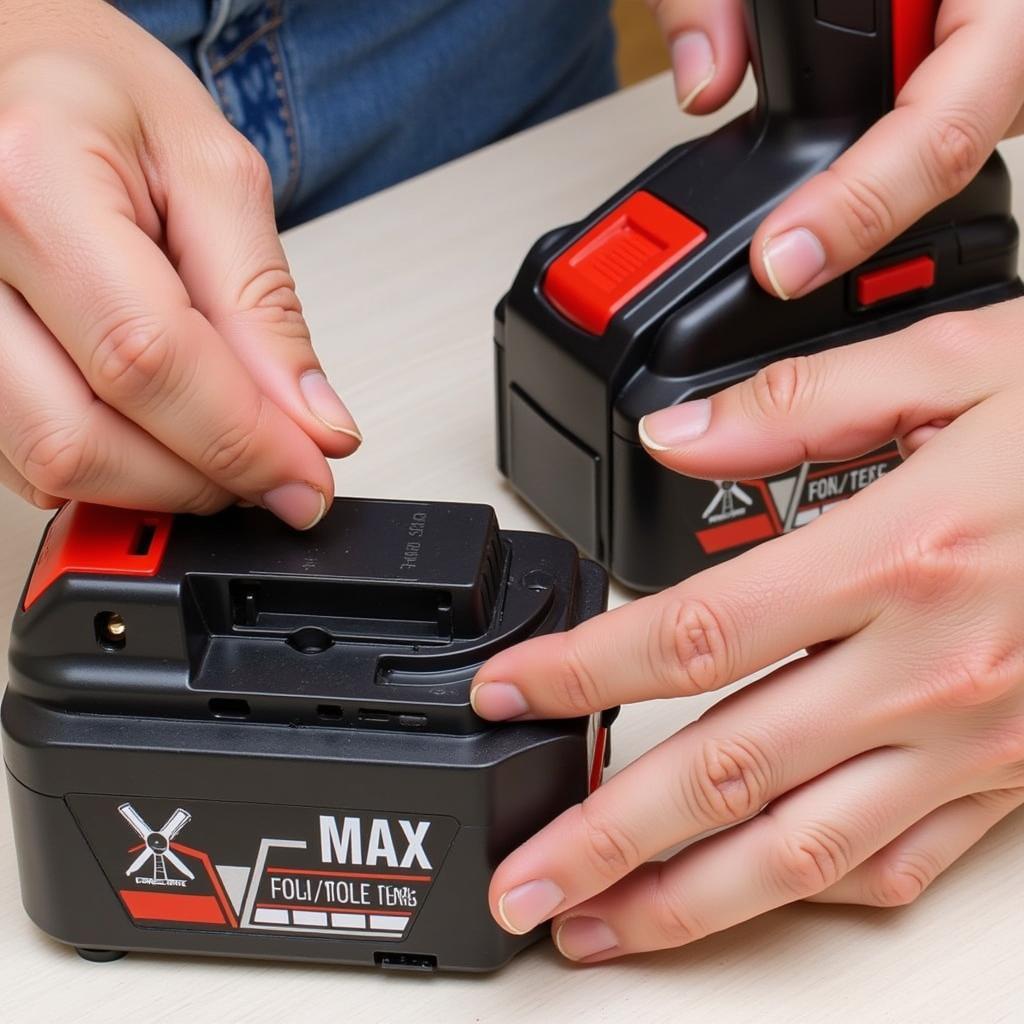Lithium-ion batteries are the powerhouse behind many of today’s cordless power tools, offering high energy density and long runtimes. Proper care is crucial for maximizing their lifespan and ensuring optimal performance. This guide will provide you with actionable steps and expert advice on How To Care For Lithium Ion Tool Batteries, keeping your tools running smoothly for years to come.
Understanding Your Lithium-Ion Tool Battery
Before diving into care tips, it’s essential to understand the basics of lithium-ion technology. Unlike older battery chemistries like nickel-cadmium (NiCd) and nickel-metal hydride (NiMH), lithium-ion batteries don’t suffer from the “memory effect,” meaning you don’t need to fully discharge them before recharging. They also boast a higher energy density, allowing for smaller, lighter batteries with longer runtimes. However, they are sensitive to temperature extremes and require specific care to maintain their health.
After fully charging your batteries, storing them in a cool, dry place will extend their life. Avoid leaving them in direct sunlight or hot cars, as extreme heat can damage the cells.
Best Practices for Lithium-Ion Tool Battery Care
Here’s a breakdown of essential practices to extend the life of your lithium-ion tool batteries:
- Optimal Charging Practices: Avoid overcharging. Most modern chargers have built-in safety features to prevent this, but it’s still good practice to unplug the battery once it’s fully charged. Partial discharges are preferable to full discharges, so don’t wait until your battery is completely drained before recharging. You can find the right charger for your tools with our guide on the tool battery charger car.
- Proper Storage: Store your batteries in a cool, dry place away from direct sunlight and extreme temperatures. Ideally, store them at a charge level of around 40-60%. This helps maintain the battery’s overall health and prevents deep discharge during storage.
- Cleaning and Maintenance: Keep your battery terminals clean by wiping them with a dry cloth. Avoid using harsh chemicals or abrasive materials that could damage the terminals. Check the battery casing for any cracks or damage regularly.
- Avoid Extreme Temperatures: Both extreme heat and cold can negatively impact lithium-ion batteries. Don’t leave your batteries in hot cars or freezing temperatures for extended periods.
- Use the Correct Charger: Always use the charger specifically designed for your battery. Using the wrong charger can damage the battery and potentially create a safety hazard.
Need help figuring out the best battery setup for your diagnostic tool? Check out our car diagnostic tool battery configuration guide.
Troubleshooting Common Lithium-Ion Battery Issues
Sometimes, despite proper care, you may encounter issues with your lithium-ion batteries. Here are a few common problems and potential solutions:
- Battery Not Holding a Charge: If your battery isn’t holding a charge as long as it used to, it might be nearing the end of its lifespan. Lithium-ion batteries have a limited number of charge cycles. Consider getting a replacement battery specifically designed for your tools. Check out the Black Decker car battery charger with diagnostics for a reliable solution.
- Battery Overheating: If your battery is overheating during use or charging, stop using it immediately and allow it to cool down in a safe location. Overheating can be a sign of a faulty battery or charger.
- Battery Not Charging: Check the charger and the battery terminals for any damage or debris. If everything appears to be in order, try a different outlet or charger.
 Troubleshooting Your Tool Batteries
Troubleshooting Your Tool Batteries
Conclusion
Properly caring for your lithium-ion tool batteries is essential for maximizing their lifespan and ensuring they power your tools effectively. By following the tips and guidelines outlined in this guide, you can keep your batteries in optimal condition and enjoy uninterrupted performance for years to come. Remember to prioritize safe charging practices, proper storage, and regular maintenance to get the most out of your lithium-ion tool batteries.
FAQ
- How often should I charge my lithium-ion tool battery? Charge it when it’s partially discharged, rather than waiting for it to fully drain.
- Can I leave my lithium-ion battery on the charger overnight? Modern chargers have safety features, but it’s best to unplug it once fully charged.
- What is the average lifespan of a lithium-ion tool battery? It varies depending on usage and care, but typically 2-3 years.
- How do I dispose of a lithium-ion tool battery? Recycle it at a designated battery recycling center or retailer.
- Can I use any charger for my lithium-ion tool battery? No, always use the charger specifically designed for your battery.
- What’s the ideal storage temperature for lithium-ion batteries? A cool, dry place at room temperature is ideal.
- How can I tell if my lithium-ion battery is damaged? Look for cracks, swelling, or overheating.
Need More Help?
For further assistance with car diagnostic tools and battery care, explore these helpful resources:
Contact us for personalized support. Reach us via WhatsApp: +1(641)206-8880, Email: [email protected] or visit our office at 910 Cedar Lane, Chicago, IL 60605, USA. We have a 24/7 customer support team available to assist you.

Leave a Reply